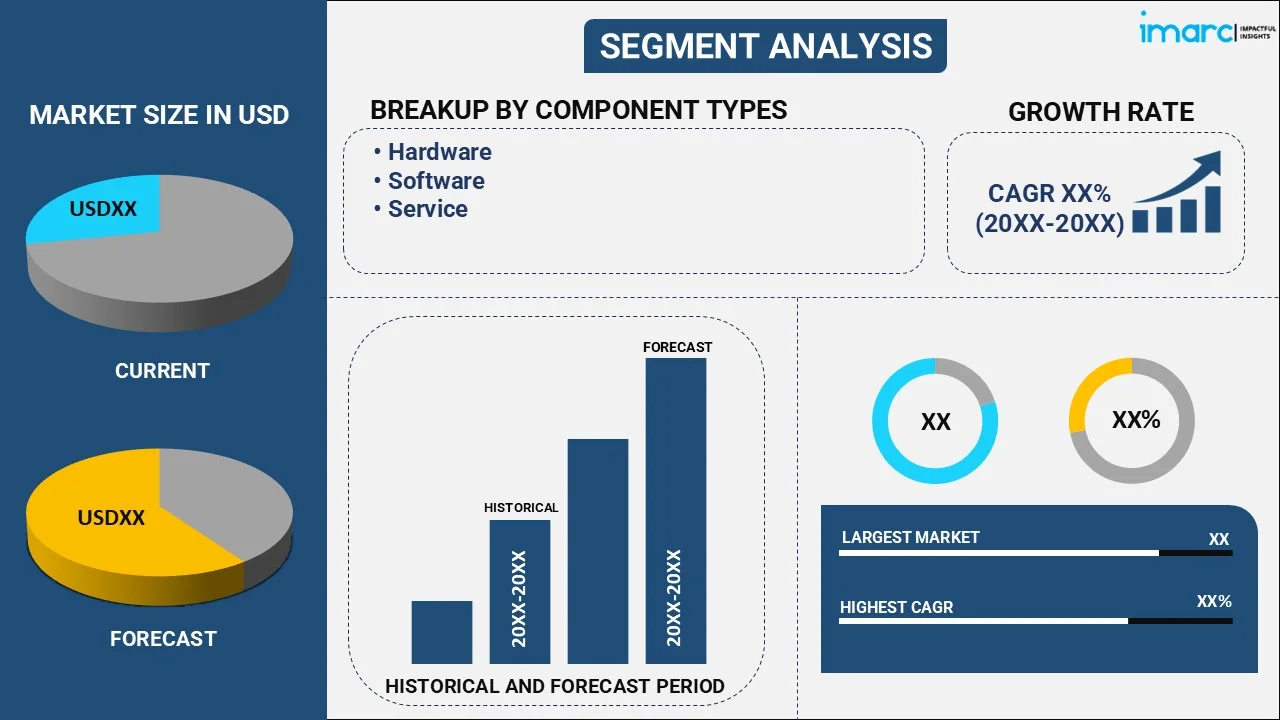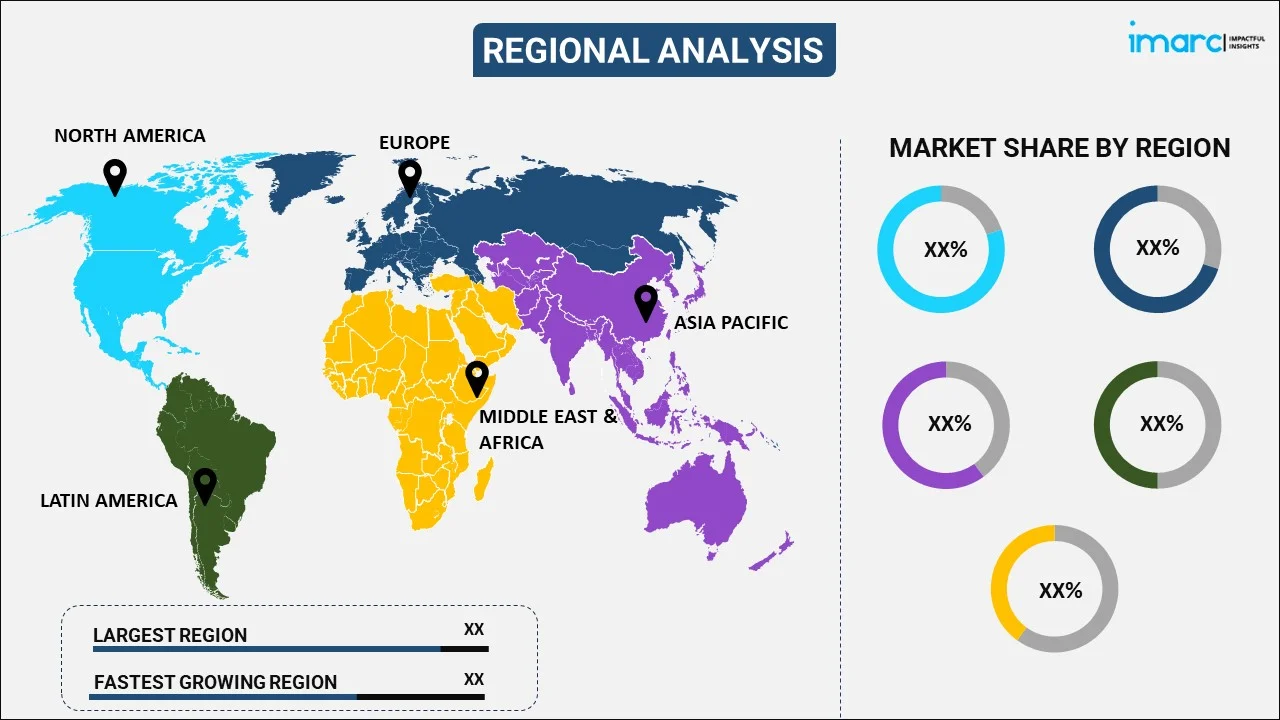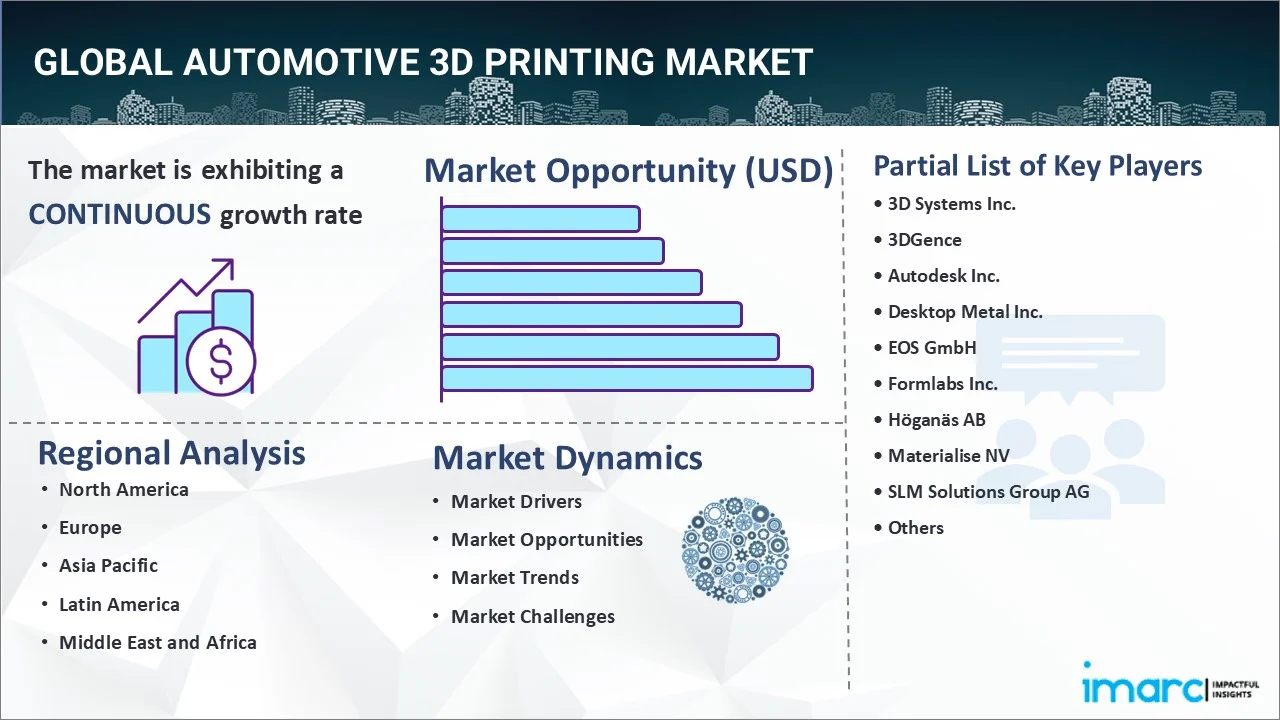
Automotive 3D Printing Market Report by Component Type (Hardware, Software, Service), Technology Type (Selective Laser Sintering (SLS), Stereo Lithography (SLA), Digital Light Processing (DLP), Electronic Beam Melting (EBM), Selective Laser Melting (SLM), Fused Deposition Modeling (FDM)), Material Type (Metal, Polymer, Ceramic), Application (Production, Innovation and R&D, Prototyping), and Region 2025-2033
Global Automotive 3D Printing Market:
The global automotive 3D printing market size reached USD 3.8 Billion in 2024. Looking forward, IMARC Group expects the market to reach USD 17.0 Billion by 2033, exhibiting a growth rate (CAGR) of 17.31% during 2025-2033. Increased demand for lightweight vehicles, continuous advances in material science, growing adoption of electric vehicles, and rising spare parts production are primarily driving the market's growth.
|
Report Attribute
|
Key Statistics
|
|---|---|
|
Base Year
|
2024
|
|
Forecast Years
|
2025-2033
|
|
Historical Years
|
2019-2024
|
| Market Size in 2024 | USD 3.8 Billion |
| Market Forecast in 2033 | USD 17.0 Billion |
| Market Growth Rate (2025-2033) | 17.31% |
Automotive 3D Printing Market Analysis:
- Major Market Drivers: The significant expansion in the automotive sector, along with the increasing demand for lightweight materials to enhance fuel efficiency in automobiles is primarily driving the market growth. Automotive 3D printing solution is widely adopted in the sector for manufacturing various complex parts of vehicles while reducing lead time, which represents a key factor primarily driving the automotive 3D printing market growth.
- Key Market Trends: The introduction of fused deposition modeling (FDM) solutions for manufacturing prototypes and concept model parts is escalating the market's growth. Moreover, the emerging trend of customized automotive parts and extensive strategic collaborations amongst key players and original equipment manufacturers (OEMs) for introducing innovative automotive 3D printing systems to meet the evolving consumer needs, are creating a positive outlook for the automotive 3D printing market share.
- Competitive Landscape: Some of the prominent automotive 3D printing market companies include 3D Systems Inc., 3DGence, Autodesk Inc., Desktop Metal Inc., EOS GmbH, Formlabs Inc., Höganäs AB, Materialise NV, SLM Solutions Group AG, Stratasys Ltd., Ultimaker BV, and voxeljet AG, among many others.
- Geographical Trends: According to the automotive 3D printing market dynamics, North America, particularly the U.S., is at the forefront of technological innovations and research in 3D printing. Many leading automotive companies and 3D printing technology providers, such as Ford, General Motors, and Tesla, are based in the U.S. Moreover, Europe is home to some of the world’s largest automotive manufacturers, including Volkswagen, BMW, Daimler, and Audi, which have increasingly integrated 3D printing into their production processes.
- Challenges and Opportunities: The high initial costs and lack of skilled workforce are hampering the market's growth. Moreover, 3D printing enables the production of highly customized automotive parts, such as custom interiors, trim pieces, and aftermarket accessories. The ability to tailor components for individual preferences or niche markets is a major opportunity, particularly in the luxury and high-performance vehicle sectors.
Automotive 3D Printing Market Trends:
Rising Sales of Automotive Vehicles
The growth in sales of automotive vehicles is significantly driving the expansion of the automotive 3D printing market. For instance, according to an article published by the Society of Indian Automobile Manufacturers, in FY-2022-23, sales of passenger cars climbed from nearly 14,67,000 to approximately 17,47,300, utility vehicles from nearly 14,89,200 to 20,03,700, and vans from nearly 1,13,200 to 1,39,000 units, compared to the previous year. The rise in vehicle sales is propelling the demand for custom vehicle components, such as interior and exterior features, which has further driven automakers to adopt 3D printing for rapid prototyping. 3D printing allows manufacturers to produce prototype parts quickly and efficiently, leading to shorter development cycles and more room for innovation in design and engineering. These factors are expected to propel the automotive 3D printing market share in the coming years.
Expanding Electric Vehicles Industry
The growing number of electric vehicles is driving the market's growth. For instance, according to IMARC, the global electric vehicle market size was estimated to be US$ 618.9 Billion in 2023. Looking forward, the market is expected to expand from US$ 786 Billion in 2024 to US$ 3,877.2 Billion by 2032, with a growth rate (CAGR) of 22.1% over the forecast period. The rise of electric vehicles (EVs) has created new demands for lightweight materials, new battery and powertrain components, and improved aerodynamics—all of which can be addressed using 3D printing. As EV manufacturing scales up globally, the adoption of additive manufacturing in this segment is accelerating. These factors further positively influence the automotive 3D printing market size.
Technological Innovations
Advanced DAPS-like systems in the automotive industry are focused on the ability to create highly detailed, functionally accurate parts. Automotive manufacturers increasingly need parts that can replicate real-world mechanical performance under extreme conditions (e.g., engine components or parts subjected to high stress), and DAPS-type technologies are advancing the precision and resolution of 3D-printed components. For instance, in October 2024, McLaren, a British automotive manufacturer, unveiled its new W1 hybrid hypercar. Titanium 3D printing was used to create the typographic uprights and wishbones for the W1's sophisticated suspension. It utilizes its 3D printing-based Divergent Adaptive Production System (DAPS). Divergent uses the automated hardware-software assembly platform to build its Czinger sports vehicles, including the 3D-printed 21C hypercar, thereby boosting the automotive 3D printing market growth.
Global Automotive 3D Printing Industry Segmentation:
IMARC Group provides an analysis of the key trends in each sub-segment of the global automotive 3D printing market report, along with forecasts at the global, regional, and country levels from 2025-2033. Our report has categorized the market based on component type, technology type, material type, and application.
Breakup by Component Type:

- Hardware
- Software
- Service
The report has provided a detailed breakup and analysis of the automotive 3D printing market based on the component type. This hardware, software, and service.
According to the automotive 3D printing market outlook, automotive manufacturers increasingly use 3D printing hardware for rapid prototyping, enabling faster and more cost-effective production of customized parts, from functional prototypes to full-scale models. Moreover, software in 3D printing refers to the programs that control the 3D printers, manage the design process, and optimize the production of automotive parts.
Breakup by Technology Type:
- Selective Laser Sintering (SLS)
- Stereo Lithography (SLA)
- Digital Light Processing (DLP)
- Electronic Beam Melting (EBM)
- Selective Laser Melting (SLM)
- Fused Deposition Modeling (FDM)
The report has provided a detailed breakup and analysis of the automotive 3D printing market based on the technology type. This includes selective laser sintering (SLS), stereo lithography (SLA), digital light processing (DLP), electronic beam melting (EBM), selective laser melting (SLM), and fused deposition modeling (FDM).
According to the automotive 3D printing market overview, SLS is well-suited for producing parts from a wide range of thermoplastics, particularly nylon (PA), which has excellent mechanical properties for automotive applications. Moreover, automotive companies use SLS to create durable prototypes and functional parts with high strength and heat resistance. It’s ideal for testing fit, form, and function in real-world scenarios. Furthermore, SLA is in demand for its ability to produce parts with high dimensional accuracy and smooth surface finishes, making it ideal for aesthetic parts or parts requiring fine detail in automotive interiors or lighting prototypes. Besides this, DLP technology has high-speed production capabilities due to its projection-based curing system, making it advantageous in rapid prototyping for automotive design iterations.
Breakup by Material Type:
- Metal
- Polymer
- Ceramic
The report has provided a detailed breakup and analysis of the automotive 3D printing market based on the material type. This includes metal, polymer, and ceramic.
The push for lighter vehicles to improve fuel efficiency in traditional vehicles and extend the range of electric vehicles (EVs) drives demand for lightweight metals like aluminum and titanium. 3D printing with these materials allows engineers to produce strong, lightweight components with optimized designs. Moreover, polymer materials are highly demanded for prototyping due to their cost-effectiveness and ease of use. Technologies like Fused Deposition Modeling (FDM), Stereolithography (SLA), and Selective Laser Sintering (SLS) enable quick iterations of design models, functional prototypes, and validation parts.
Breakup by Application:
- Production
- Innovation and R&D
- Prototyping
The report has provided a detailed breakup and analysis of the automotive 3D printing market based on the application. This includes production, innovation and R&D, and prototyping.
3D printing is increasingly being adopted for direct production of end-use parts in the automotive industry. While it may not yet fully replace traditional mass production techniques like injection molding or die casting, it has found important niches in low-volume production, customization, and spare parts manufacturing. Moreover, prototyping is one of the most established and widespread applications of 3D printing in the automotive industry. Additive manufacturing significantly accelerates the design process, enabling rapid testing and refinement of parts before they move to full-scale production. This is further positively influencing the automotive 3D printing market share.
Breakup by Region:

- North America
- United States
- Canada
- Asia-Pacific
- China
- Japan
- India
- South Korea
- Australia
- Indonesia
- Others
- Europe
- Germany
- France
- United Kingdom
- Italy
- Spain
- Russia
- Others
- Latin America
- Brazil
- Mexico
- Others
- Middle East and Africa
The report has also provided a comprehensive analysis of all the major regional markets, which include North America (the United States and Canada); Europe (Germany, France, the United Kingdom, Italy, Spain, Russia, and others); Asia Pacific (China, Japan, India, South Korea, Australia, Indonesia, and others); Latin America (Brazil, Mexico, and others); and the Middle East and Africa.
According to the automotive 3D printing market statistics, North American region’s emphasis on research and development drives innovation in materials and processes, with many companies using 3D printing to develop lightweight and energy-efficient vehicles, especially electric vehicles (EVs). Moreover, Europe, particularly Germany, is home to some of the world’s largest automotive manufacturers, including BMW, Audi, Mercedes-Benz, and Volkswagen, all of which are adopting 3D printing to enhance production processes, reduce costs, and innovate in vehicle design.
Competitive Landscape:
The market research report has provided a comprehensive analysis of the competitive landscape. Detailed profiles of all major market companies have also been provided. Some of the key players in the market include:
- 3D Systems Inc.
- 3DGence
- Autodesk Inc.
- Desktop Metal Inc.
- EOS GmbH
- Formlabs Inc.
- Höganäs AB
- Materialise NV
- SLM Solutions Group AG
- Stratasys Ltd.
- Ultimaker BV
- voxeljet AG
(Please note that this is only a partial list of the key players, and the complete list is provided in the report.)
Automotive 3D Printing Market Recent Developments:
- October 2024: McLaren, a British automotive manufacturer, unveiled its new W1 hybrid hypercar. Titanium 3D printing was used to create the typographic uprights and wishbones for the W1's sophisticated suspension. It utilizes its 3D printing-based Divergent Adaptive Production System (DAPS).
- June 2024: Stratasys and BASF launched SAF Polypropylene for the H350 3D printing system. The SAF PP is intended to increase cost efficiency and improve part quality in Powder Bed Fusion technology.
- May 2024: Auto Additive launched 3D Printing for Vehicle Repairs. Auto Additive, which has a team of 3D scanning and reverse engineering specialists, offers 3D printing services and materials.
Automotive 3D Printing Market Report Scope:
| Report Features | Details |
|---|---|
| Base Year of the Analysis | 2024 |
| Historical Period | 2019-2024 |
| Forecast Period | 2025-2033 |
| Units | Billion USD |
| Scope of the Report | Exploration of Historical Trends and Market Outlook, Industry Catalysts and Challenges, Segment-Wise Historical and Future Market Assessment:
|
| Component Types Covered | Hardware, Software, Service |
| Technology Types Covered | Selective Laser Sintering (SLS), Stereo Lithography (SLA), Digital Light Processing (DLP), Electronic Beam Melting (EBM), Selective Laser Melting (SLM), Fused Deposition Modeling (FDM) |
| Material Types Covered | Metal, Polymer, Ceramic |
| Applications Covered | Production, Innovation and R&D, Prototyping |
| Regions Covered | Asia Pacific, Europe, North America, Latin America, Middle East and Africa |
| Countries Covered | United States, Canada, Germany, France, United Kingdom, Italy, Spain, Russia, China, Japan, India, South Korea, Australia, Indonesia, Brazil, Mexico |
| Companies Covered | 3D Systems Inc., 3DGence, Autodesk Inc., Desktop Metal Inc., EOS GmbH, Formlabs Inc., Höganäs AB, Materialise NV, SLM Solutions Group AG, Stratasys Ltd., Ultimaker BV, voxeljet AG, etc. |
| Customization Scope | 10% Free Customization |
| Post-Sale Analyst Support | 10-12 Weeks |
| Delivery Format | PDF and Excel through Email (We can also provide the editable version of the report in PPT/Word format on special request) |
Key Benefits for Stakeholders:
- IMARC's report offers a comprehensive quantitative analysis of various market segments, historical and current market trends, market forecasts, and dynamics of the automotive 3D printing market from 2019-2033.
- The research study provides the latest information on the market drivers, challenges, and opportunities in the global automotive 3D printing market.
- The study maps the leading, as well as the fastest-growing, regional markets. It further enables stakeholders to identify the key country-level markets within each region.
- Porter's five forces analysis assists stakeholders in assessing the impact of new entrants, competitive rivalry, supplier power, buyer power, and the threat of substitution. It helps stakeholders to analyze the level of competition within the automotive 3D printing industry and its attractiveness.
- The competitive landscape allows stakeholders to understand their competitive environment and provides insight into the current positions of key players in the market.
Key Questions Answered in This Report
The automotive 3D printing market was valued at USD 3.8 Billion in 2024.
The automotive 3D printing market is projected to exhibit a CAGR of 17.31% during 2025-2033.
The automotive 3D printing market is driven by the demand for rapid prototyping, reduced production costs, and customization of vehicle components. Technological advancements, material innovation, and the shift toward electric vehicles (EVs) further support growth. Additionally, 3D printing's ability to reduce waste and enhance design flexibility boosts market adoption.
North America currently dominates the market driven by the increasing demand for lightweight, customized parts, and faster prototyping.
Some of the major players in the automotive 3D printing market include 3D Systems Inc., 3DGence, Autodesk Inc., Desktop Metal Inc., EOS GmbH, Formlabs Inc., Höganäs AB, Materialise NV, SLM Solutions Group AG, Stratasys Ltd., Ultimaker BV, voxeljet AG, etc.
Need more help?
- Speak to our experienced analysts for insights on the current market scenarios.
- Include additional segments and countries to customize the report as per your requirement.
- Gain an unparalleled competitive advantage in your domain by understanding how to utilize the report and positively impacting your operations and revenue.
- For further assistance, please connect with our analysts.

 Inquire Before Buying
Inquire Before Buying
 Speak to an Analyst
Speak to an Analyst
 Request Brochure
Request Brochure
 Request Customization
Request Customization




.webp)




.webp)












